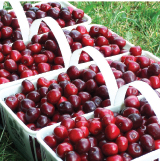
Features
Production
Research
Managing crop load creates efficient cherry orchards
It creates efficient cherry orchards
March 4, 2008 By Peter Mitham
High-efficiency systems will be critical to the future of sweet cherry production, according to Matthew Whiting, assistant professor and horticulturist at Washington State University in Prosser, Wash.
 |
| Efficient orchard architecture can allow for mechanical harvesting, which is ideal for taking advantage of marketing opportunities, such as stemless cherries. |
High-efficiency systems will be critical to the future of sweet cherry production, according to Matthew Whiting, assistant professor and horticulturist at Washington State University in Prosser, Wash.
The effective management of cherries is possible through efficient orchard architecture and crop load management, says Whiting, adding the goal is to create “individual management units” that improve a grower’s ability to attend to not just each tree but each fruiting offshoot.
“We want to minimize the management unit,” Whiting told growers during the British Columbia Fruit Growers’ Association annual Horticultural Forum, held in Penticton, B.C., last November.
He urges growers to envision an orchard that effectively functions with the ease of an assembly line. One example Whiting gives is of an orchard system that creates vertical walls of fruit through a series of upright branches. The uprights are spaced 18 inches apart. The system allows growers to pay closer attention to the essential tasks of pruning, managing levels of giberellic acids (plant hormones that regulate growth) and thinning.
Since well-positioned offshoots catch sufficient amounts of light to effect maturity, the grower’s work primarily focuses on crop load management. Whiting is exploring various strategies from hand thinning through mechanical methods and chemical thinning.
Ideally, Whiting strives for a 45 to 50 per cent fruit set on his Rainier cherries grafted on Mahaleb rootstock. But wide variability in natural fruit set creates challenges in managing crop load because the exact amount of fruit set is difficult to determine prior to bloom. A grower risks thinning too much if fruit set proves low, while higher fruit set may be difficult to achieve.
Being able to accurately set targets requires understanding how the various thinners operate. Whiting’s research has found that post-bloom thinning (ideally two to four weeks after full bloom) plays an important role not only in ensuring the correct number of blooms but also in
managing fruit size.
The effective management of crop load also has benefits for production, as Whiting explained in a workshop following his presentation.
Efficient orchard architecture can allow for mechanical harvesting, which is ideal for taking advantage of marketing opportunities, such as stemless cherries. The rewards can be significant – while the average cherry costs 20 to 24 cents a pound to harvest, a mechanical harvester that shakes the trees to release the ripe fruit can reduce the per-pound cost to two cents.
Up to 85 per cent of fruit can be collected in this way, with about half the remainder staying on the trees and the rest landing on the ground.
It takes 400 grams psi of pressure to release fruit from the pedicle, Whiting said. Skeena is ideal because it reaches this point by the standard harvest date of mid-July.
While surveys indicate that buyers are not necessarily willing to pay a premium for the stemless cherries gathered by mechanical harvesters, lower labour costs mean growers can come out ahead. And, Whiting said, there’s a lower chance of losses since the chance of contact with the stem’s woody fibre is virtually eliminated.
“You’ve virtually eliminated pitting,” he said.
In addition, mechanical harvesters create the potential for night harvesting, meaning fruit can be harvested when it’s cooler, meaning less of a temperature shock when its cooled for storage and shipping.
Stemless cherries also provide plenty of innovative packing opportunities, Whiting said. A survey of Calgary consumers in 2005 suggested that 39 per cent of consumers preferred stem-free cherries, and Whiting threw out the idea of packaging the fruit in clear tubes as an option.
But without the right architecture, Whiting said, growers will continue to grapple with ripening and harvesting
appealing fruit. No matter how cherries are sold, everything comes back to the
orchard.
“It all depends on how well you’ve managed those trees,” he said.
Print this page